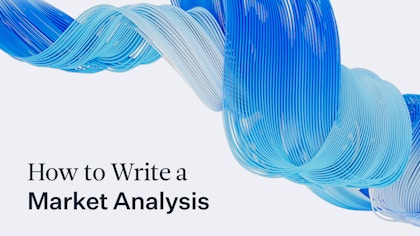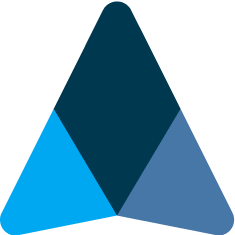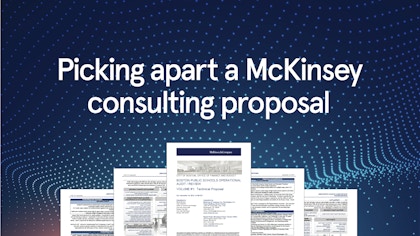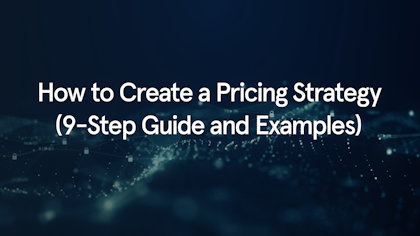During our own years at BCG and Bain, we were part of creating hundreds of project proposals. These consulting proposals always followed a set structure with a focus on the client’s issues and making it as easy as possible for the client to say yes to the project, despite high fees.
This secret sauce for creating winning proposals is easier to learn through examples rather than long text books. In this blog post, we’ll therefore break down a real-life McKinsey request for proposal (RfP) response and look at what works well and why.
If you want to see more real consulting proposals you can read our blog post here, or get a headstart with our Consulting Proposal template that includes a detailed guide, ready-to-use slides, and a full-length winning consulting proposal example for inspiration.
Background for this proposal
The consulting proposal example we’re looking at in this blog post was originally submitted by McKinsey & Company to the City of Boston in response to an official Request for Proposals (RFP).
The City of Boston wanted to conduct an operational review of the Boston Public Schools to identify operational improvements and how to move forward. McKinsey ended up winning the project and conducting the operational audit, although their findings did lead to some controversies.
McKinsey’s proposal: “BOSTON PUBLIC SCHOOLS OPERATIONAL AUDIT / REVIEW, VOLUME #1: Technical Proposal”
Date: November 10 2014
Cost: $660,000
Duration: 8 weeks
Note that this proposal is written as a Word document. This is very common for public institution proposals, where most private sector proposals we have been a part of have consisted mainly of slide decks. The desired format of the proposal is often stated in the Request for Proposals.
Now let’s dig into the proposal.
How McKinsey wrote a winning proposal
A good proposal should focus on making it easy for the client to say “yes”. This means the proposal should:
- Inspire confidence that the consultants know what they are talking about
- Be clear on a plan so it feels like the project will go off without a hitch
- Hit all the points specified in the RfP
Let’s see how this McKinsey proposal achieves that.
Step 1: Make it all about the client
First off, since this was a response to an RfP, there were certain elements that the proposal had to include. This list was the following:
However, McKinsey knows that a great consulting proposal does not simply list who the bidder is and how they will go about conducting the requested project. A great consulting proposal turns the proposal around to focus on the client’s needs and problems and demonstrate a thorough understanding of the client’s situation.
In practice, the McKinsey team has done this by first writing a cover letter that succinctly summarizes the objectives of the project and connects that to the specific McKinsey experience that will help achieve these objectives. By summarizing the objectives in this way, McKinsey shows the client right off the bat that they understand what the client wants to accomplish. Although it may seem trivial to construct the cover letter in this way, it’s one of the subtle tactics to build the client’s confidence in your team and approach.
Opening the actual proposal is a section titled “Our understanding of the Boston Public Schools (BPS) system”. This section breaks down what McKinsey from the outlook sees as the core problems and opportunities in the client’s situation. Notice how the problems are confidently stated with facts. This requires some serious work ahead of the proposal to be able to create a good enough data background.
Most consulting houses invest somewhere between a few days and several weeks of work to put together the research required for proposals like this. However, it is often a good ROI since it allows the consultants to demonstrate that they have a deep, data-driven approach from the outset and are able to “hit the ground running”. In addition, it often makes the clients feel more special since the consultants have done “free” work for them and already provided valuable insights.
Including such a data-driven client-first section is the best-practice approach to writing proposals and something that is often worth investing time and effort in.
What McKinsey also subtly does here is introduce the “S” and “C” of the SCR (situation-complication-resolution) framework. They are playing back the situation and highlighting the complication to the client and making the client feel heard and understood, as well as building the foundation for why their proposed solution is the right one.
Step 2: Tailor your experience to fit the project needs
Following the opening section is the official “offerer profile” section as requested in the RfP.
However, again McKinsey doesn’t just include a standard description of their firm. Instead they focus heavily on demonstrating past experience with the exact topics that the potential project will address. And again showing that they understand the scope and objectives of the project by highlighting what they know that will be important in a situation like the client’s.
More specifically, they use the bullet points under the section titled “McKinsey’s Industry Knowledge and Experience” to showcase different dimensions where the client might have doubts, thereby positioning McKinsey as the ideal, no-regret choice:
The most important purpose of a section like this is not to talk at length about all the things McKinsey is good at. Instead, the point is to mitigate any concerns the client may have so it is as easy for the client to say yes as possible. For example, the last bullet includes the following text:
Of all the U.S. Government Contractor Performance Assessment Reports (CPARs) received as of January 2012, 100 percent of Contract Officers wrote that they would definitely work with McKinsey again.
Including a statistic like this gives the person or persons on the client side who will decide, the safety in knowing that 0% of their peers in other institutions and teams have regretted their decision. McKinsey knows that in the end it comes down to someone wanting to do a good job and bullet points like these make it seem like a safe move.
Rounding out the section are the requested references from the RfP. However, again McKinsey goes above and beyond by a) including paragraphs specifically on the relevance to the proposed project, b) describing the specifics of each case in details where the tasks would be similar to the proposed project, c) including concrete results and outcomes, and d) including four references even though three had been enough according to the RfP.
This all helps reinforce the perception that McKinsey knows exactly what the client needs and can hit the ground running.
Step 3: Go deep on the project plan
Once McKinsey has given the client confidence that they understand their situation and have already done lots of similar projects, the McKinsey team dives into the meat of the proposal; a long section titled “Technical proposal in response to the scope of services”. This is the “how it will get done”/resolution portion of the proposal.
Where the first sections focused on demonstrating that McKinsey are the right people for the job, the last section is meant to give peace of mind that the project will run smoothly, meet deadlines, involve the right stakeholders, and ultimately end up as a success for the client.
McKinsey does this by first including a section that they call “Day 1 Perspectives on Key Issues”. This section is again, like the first section, very focused on the problem at hand and delivering a qualified view on the starting point.
Even if these points are perhaps only 70-80% right, it shows the client that McKinsey has already had well-founded thoughts on the matter, has access to relevant data, and is able to turn that data into insights.
It is much easier to give feedback on something than to start from scratch and McKinsey knows this. By including these Day 1 perspectives, they show the client that we don’t have to start from scratch but can hit the ground running. This type of approach is very effective because it makes it seem like the client is getting some research for free.
Once we get to the project plan, it looks fairly simple and generic. However, here McKinsey also includes some tips and tricks. They highlight the regular check-ins, giving the client peace of mind that key stakeholders will be heard and thus the entire project is seen as more successful. In addition, they highlight their “broad-then-deep” approach which allows the client to rest assured that nothing important is missed along the way.
Step 4: Roll out all your experts
Now that McKinsey has given the client confidence that they understand the project and have a solid plan, it is time to clinch the deal by showcasing their talent. First, McKinsey includes a staffing diagram that has both the actual project team from McKinsey, as well as who should be involved from the client side and which stakeholders and experts should be heard.
By including client people in the proposed team, McKinsey is showing the client that they understand how important it is to work collaboratively and that they already now know who the key stakeholders are and who needs to be happy in order for the project to be deemed a success.
In addition, by including a long list of McKinsey experts they are building a sense of FOMO that the client will miss out on all these great insights if they choose to go with someone other than McKinsey. This is a highly effective tactic.
McKinsey has also chosen to use a graphical format to communicate the staffing plan. This is a best-practice move and makes it easy for the client to comprehend the setup despite a lot of information. The same information in text format had been nearly impossible to digest as effectively.
Following the team setup, McKinsey has added a skills matrix. This is an easy way to highlight how qualified your team is and for the client to cross-check with their own requirements as specified in the RfP. It is also a subtle way to show that McKinsey understands which specific skills are most important in a project like this, and again gives the client confidence that McKinsey has thoroughly understood what the project needs to achieve and what success looks like.
Finally, McKinsey ends the main part of the proposal with resumés of their staff and strong case experiences that are tailored to the proposed project in line with the references.
McKinsey further includes the team resumés in full-length in the appendix. Here they have picked the specific projects for each team member that are most relevant to the project at hand.
McKinsey also adds some of their frameworks in the appendix. This again serves to further bolster the image that they have done projects like this many times before and know exactly what is needed to make it a success.
Step 5: Break down the price to make it digestible
The final step in a winning proposal is setting up a price that seems reasonable. In this particular case, the price proposal is separate and has not been disclosed. However, it has been stated publicly that the project cost $660,000.
Instead, let’s look at a few other examples of how a price proposal can be set up.
In the first example from a cost proposal for additional work in an existing project, McKinsey offers three price options depending on the scope of work:
This is a classic way to make the price seem digestible and turns the conversation away from discussing how expensive McKinsey is in general and over to what option is best suited for the client now.
In the second example from another government project, McKinsey prices by deliverable:
By dividing up the price in so many deliverables, it makes the total cost seem more moderate.
Finally, in the third example from a proposal for the State of New Jersey, McKinsey prices the project as a firm-fixed-price but emphasizes in the description that the price includes not just the main team but also “several part-time or full-time Partners and subject matter experts, in addition to research, graphical production, and administrative support”. In addition, McKinsey adds the use of a proprietary capability, the OrgLab, as an explicit line item set to zero. The incremental cost for McKinsey for using the capability is likely zero, but by calling it out this way it feels like the client is getting a lot of value for free:
You can see several more examples of Bain, BCG, and McKinsey proposals in our collection of downloadable proposals.
Take your own proposal writing to the next level
Now that we’ve gone through a full McKinsey proposal and picked apart why it works, it’s time to sum up the lessons.
The first and most important lesson is that McKinsey in effect uses the SCR framework throughout. This is a best-practice move and in this proposal McKinsey shows us both how the framework can still be applied in an RfP setting and how it can be applied in a text/Word document format as opposed to slide format.
Below is an example of how the SCR framework translates to a compelling proposal storyline from our Consulting Proposal template:
In addition to using the SCR framework as the basis, there are several other small tips and tricks we can learn from the McKinsey proposal:
- Play back the client’s situation and issues to demonstrate understanding of the brief and generate trust from the get go.
- Tailor your experience to that specific project by including how it is relevant to the project at hand and only including case examples and references that directly demonstrate some of the skills needed in the proposed project.
- Do some upfront research and include the insights as Day 1 perspectives or similar to show the client you can hit the ground running.
- Include the client team in your staffing setup to demonstrate that you will prioritize collaboration.
- Include key stakeholders from the client to show that you understand who needs to be happy in order for the project to be a success.
- Include team resumés and describe the elements of each person’s past experience that are relevant to the project at hand.
- Don’t be afraid to include data and conclusions from research, even if this is not 100% correct. The 80% version demonstrates analytical abilities and that you are ready for the project.
That concludes our McKinsey proposal analysis. If you want to read more about creating your own best-practice proposal check out our blog post on the topic. Or get a headstart on your proposal using our ready-made PowerPoint template.































